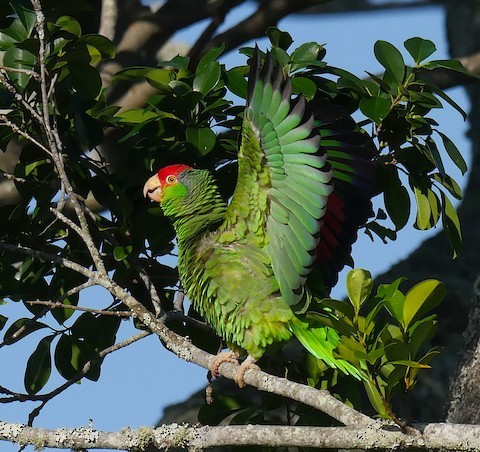Aiea Ridge, Oahu, Hawaii
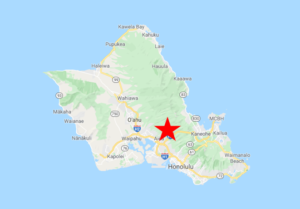
Aiea Ridge is the most productive place to search for forest birds on Oahu, with local populations of both of the island’s remaining endemics, the Oahu Elepaio and the Oahu Amakihi, and its other surviving honeycreeper, the Apapane. It is the world’s most accessible site for Mariana Swiftlet, which often hunts over the ridge due to its proximity to the colony in the North Halawa Valley, and it is within the home range of a large flock of introduced Red-crowned Parrots. Other exotics often found along the trail include White-rumped Shama, Red-vented and Red-whiskered Bulbuls, Japanese Bush-Warbler, Warbling White-eye, and Red-billed Leiothrix.
Orientation
Directions
Aiea Ridge is in the southcentral Ko’olau Range overlooking Pearl Harbor, accessed via a trail that begins in Keaiwa Heiau State Recreation Area, about 20 minutes’ drive (10 miles) northwest of Honolulu, or 15 minutes (7 miles), north of Hawaii’s largest airport, Daniel K. Inouye International.
From Downtown Honolulu. Take the main freeway, H1, northwest out of the downtown area and keep left at the fork to continue northwest on the Moanalua Freeway (H201) toward Aiea. After about 4.5 miles on H201, take the Stadium / Aiea exit onto Moanalua Road, then immediately turn right onto Kaimakani Street.
Kaimakani ends at a T-junction with Ulune Street. Turn left onto Ulune, then immediately fork right onto Halewiliko Street. After a quarter-mile, fork right again onto Aiea Heights Drive, and remain on it for 2.4 miles, where it ends at the entrance to Keaiwa Heiau State Recreation Area. Proceed to the upper (eastern) trailhead for the most direct access to Aiea Ridge.
From the Airport. Take the main freeway, H1, north for about 4 miles to Exit 13A, the Moanalua Freeway (H201). Keep to the right lane of H201 and take the first exit (Stadium / Aiea) onto Moanalua Road, then immediately turn right onto Kaimakani Street , and continue as described above (via Ulune, Halewiliko, and Aiea Heights Drive).
Birdfinding
Access to Aiea Ridge involves hiking up two trails. The lower portion is the Aiea Loop Trail, which runs along the perimeter of Keaiwa Heiau State Recreation Area for a total of 4.8 miles. At the highest point of the loop (1.5 miles from the upper trailhead, or 2.3 miles from the lower trailhead), the Aiea Ridge Trail branches off to the east and continues along the ridge, ending at Aiea Summit. The distance from the upper trailhead to Aiea Summit is about 4.5 miles one-way: 1.5 miles on the loop trail, then 3 miles on the ridge trail. The complete round-trip hike is therefore about 9 miles.
(Note that the Aiea Ridge Trail becomes slippery in wet weather and is not always safely passable. The first and last segments tend to be the most treacherous.)
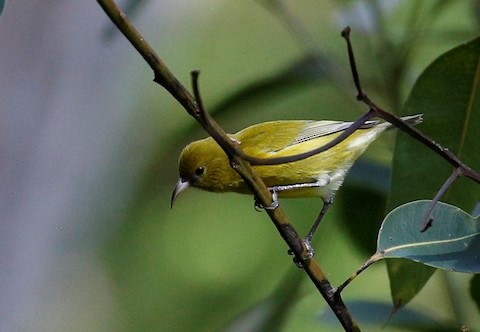
Male Oahu Amakihi at Aiea Ridge. © Laura Keene
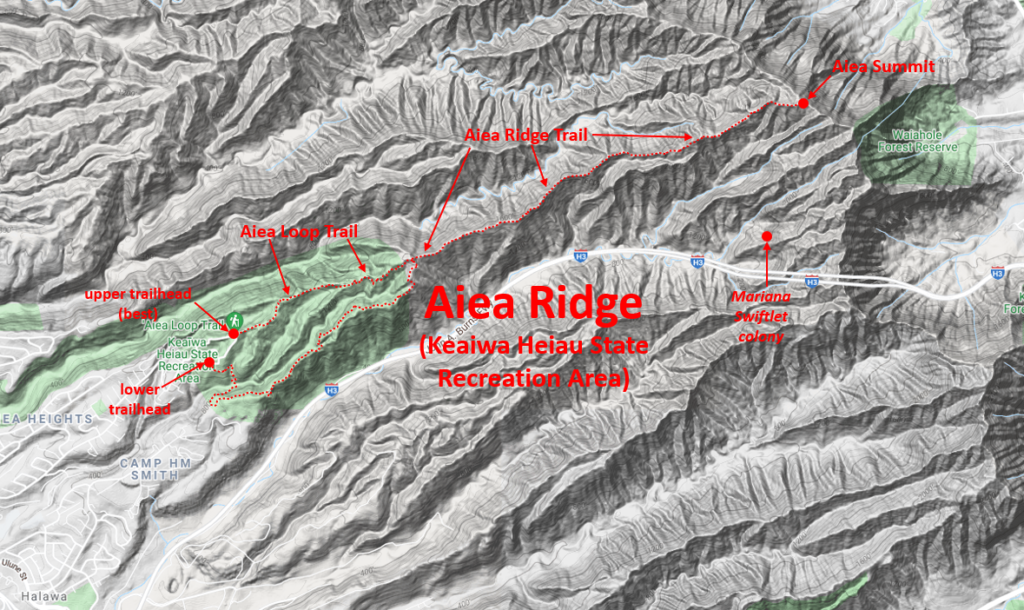
The birds of interest at Aiea Ridge are generally more likely to be found on the higher ground, starting from the upper portion of the Aiea Loop Trail where native flowering trees become dominant, and continuing up the length of the Aiea Ridge Trail. The Oahu Amakihi and Apapane depend on these trees and move restlessly across the landscape in search of fresh sources of nectar.
The Oahu Elepaio is confined to the same forests but remains in the undergrowth alongside three interesting introduced Asian species, the White-rumped Shama, Japanese Bush-Warbler, and Red-billed Leiothrix, as well as commoner exotics such as Red-vented and Red-whiskered Bulbuls, Warbling White-eye, and Red-crested Cardinal.
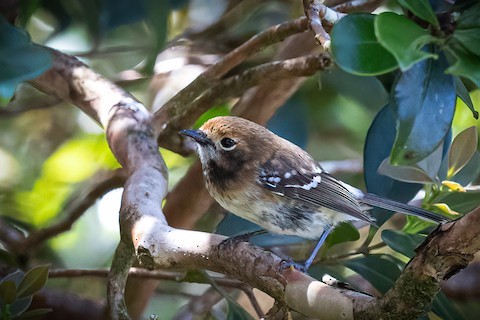
Oahu Elepaio at Aiea Ridge. © Isaac Sanchez
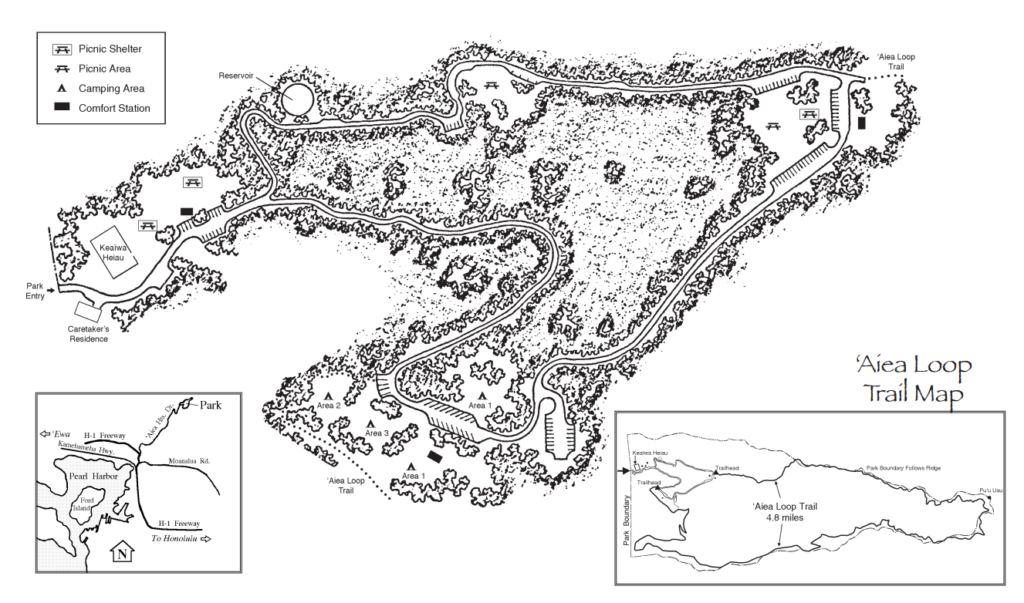
Mariana Swiftlet. The introduction of the Mariana Swiftlet to Oahu is an unusual story with unusual results. In 1962, for the stated purpose “to provide aesthetic enjoyment to persons who would appreciate observing and studying this interesting species,” the Hui Manu Society transported between 125 and 175 swiftlets from their native Guam to Oahu and released them in the Niu Valley above Honolulu. Three years later, they augmented the first release with 210 more swiftlets released at Waimea Falls on the North Shore of Oahu.
The birds vanished into the landscape, with only infrequent sightings through the years until 1978, when a nesting colony was discovered in a manmade tunnel in a tributary of the North Halawa Valley, at a fairly inaccessible location that is just north of the H3 Freeway about a mile west of its crest—about a mile south of the upper end of Aiea Ridge.

Mariana Swiftlet in tunnel in North Halawa Valley. © Nathan Christopher Johnson
Meanwhile in its native range on Guam and four other Mariana Islands, the swiftlet was disappearing due to the human introduction of certain predators. By the late 1900s, the swiftlet was extirpated from two islands and greatly diminished on two others, with a still-healthy population remaining only on Saipan.
The wayward Oahu population, numbering around 150, has thus become an insurance policy against extinction of the species, and the only known example of an introduced swift population.
Red-crowned Parrot. Central Oahu is also home to an introduced population of Red-crowned Parrots, which has been growing steadily since the 1980s. Their primary origin appears to have been an aviary in Aiea, damaged by Hurricane Iwa in 1982, resulting in the unintentional release of a few pairs. By 1987, a flock of 32 was reportedly inhabiting Pearl City, and by 2008 it had grown to more than 200.
These parrots reportedly roost in Eucalyptus groves along Manana and Waimano Ridges, a few miles north of Aiea Ridge. They forage over a wide portion of central Oahu, north to Schofield Barracks and Wahiawa, and south to Aiea, with a few occasionally wandering south into Honolulu and its hillsides. Sightings at Aiea Ridge have increased in regularity.
Services
Accommodations
Honolulu has an abundance of accommodations concentrated in Waikiki, 12 miles south of Aiea Ridge.
Keaiwa Heiau State Recreation Area has ten campsites available five nights per week, from Friday evening to Wednesday morning: $30/night (per campsite) for non-residents.
Notes
When to Visit
Keaiwa Heiau State Recreation Area is open daily from 7:00 a.m. to 6:45 p.m.
Hazards & Hassles
Expect rain and wet, muddy, slippery trail conditions.
Links
